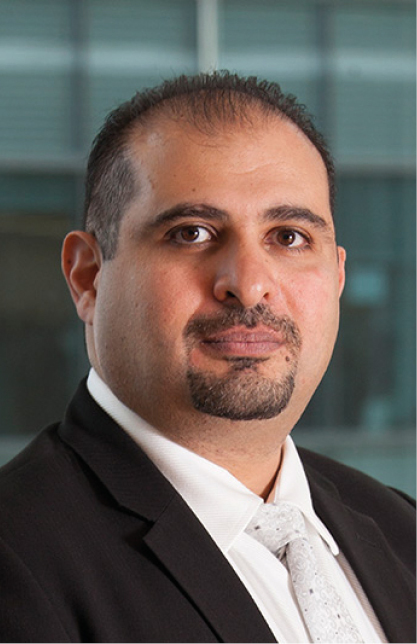Navigating international headwinds in Islamic asset management

Alastair Sewell and Bashar Al-Natoor
There are challenges ahead for the global Islamic asset management industry, but also structural drivers that could support further growth, say Alastair Sewell, CFA and Bashar Al-Natoor.
The Islamic asset management industry is a key pillar of Islamic finance. The industry is growing quickly, having crossed an estimated $3 trillion at end-2021 – as are Islamic banks, sukuk and takaful (Islamic insurance). The availability of Islamic funds has also grown rapidly in multiple jurisdictions around the world, including, increasingly, in non-Islamic domiciles. This combination of growing investment heft and international presence suggest that more growth may follow. However, economic and market headwinds now abound. Successfully navigating current investment challenges could be critical to the sector’s continued growth.
Assets under management (AUM) in Islamic mutual funds have increased substantially. At Fitch Ratings we estimate that assets in Islamic funds grew at an annualised rate of around 13% over the five years to end-3Q21. By way of comparison, all mutual funds globally grew at around 11% over the same period. In cumulative terms this amounts to 84% growth in Islamic funds, compared to just 68% in all mutual funds.
While the growth rate is strong, the context is important: global mutual fund assets totalled around $68 trillion at end-2021, whereas Islamic mutual fund assets peaked at around $130 billion at the end of the second quarter, before falling to around $120 billion at end-2021. Accordingly, the relatively small size of Islamic funds could have amplified the growth rate. Compared with Islamic issuance markets, the fund sector remains small as well.
Fitch estimates global outstanding sukuk reached $711.3 billion in 2021, 12.7% higher than a year before. Sukuk has become a key funding tool in the core markets of the Gulf Cooperation Council, Malaysia, Indonesia, Turkey and Pakistan with a 31% share of the total funding mix at end-2021. Green and sustainable sukuk volumes expanded 17.2% year-over-year in 2021 to $15 billion, with the theme likely to remain prominent in 2022. The industry is also expanding its product offerings and diversity, including ESG-linked sukuk, which speaks to its rising maturity.
Saudi Arabia and Malaysia Dominate Market
The major Islamic domiciles with the deepest capital markets have the most established Islamic asset management industries. Saudi Arabia and Malaysia are the pre-eminent Islamic fund domiciles worldwide, together accounting for almost two thirds of industry assets. Saudi Arabia-domiciled funds had $41.5 billion total AUM at end-2021, compared with $35.5 billion in Malaysia, according to Lipper for Investment Management. Both also have established mutual fund regulation. Developments in these jurisdictions are therefore meaningful to the industry overall.
Money market funds (MMFs) dominate in Saudi Arabia, accounting for around 83% of total assets, according to Lipper. This is consistent with the overall picture globally: MMFs are the largest Islamic fund type by AUM, representing 41% of all fund assets worldwide according to Lipper. MMFs are typically one of the first fund types to develop in fund markets – they will usually invest in high-credit-quality securities with maturities of up to one or two years, while offering investors the ability to subscribe or redeem daily or near-daily, and enable access to capital markets securities that otherwise would only be directly available to the largest and most sophisticated investors. However, MMFs also expose investors to maturity transformation risk. Managing liquidity risk is therefore a primary focus for MMF providers.
Even though they typically focus on high-credit-quality securities, MMFs still face credit risk. A number of sukuk issuers defaulted in 2021, including Serba Dinamik Holdings Berhad and PT Garuda Indonesia. Legal precedent for effective enforcement is lacking in many sukuk-issuing jurisdictions. For example, we observed some Saudi Arabian MMFs affected by a sukuk default in 2020. However, defaulted sukuk volumes remained extremely small at 0.2% of gross sukuk issued as at end-2021.
Many Islamic jurisdictions have updated their bankruptcy laws in recent years, but it remains to be seen how bankruptcy courts would treat sukuk defaults compared to bond defaults in such events, whether investors will have full recourse to the issuers, and if sukuk certificate holders will be able to enforce their contractual rights in local courts. Accordingly, MMF providers need strong credit analysis capabilities, as well as a keen focus on potential legal and regulatory issues affecting their holdings.
Demand for MMFs in Saudi Arabia has been strong, despite the default. Saudi Arabian mutual fund AUM grew by 80% over 2019–2021, driven by MMFs, with a growing number of funds available. This growth was driven, to some extent, by new wealth generation, although there may also have been some reallocation of cash from bank deposits to MMFs. In these cases, the effect on banks is typically muted as many banks own investment managers providing MMFs, and the MMFs themselves will invest both in short-term bonds and bank deposits. Future demand will therefore be a function of new savings generation and investor preference in terms of bank deposits or funds as savings products.
Malaysia’s mutual fund sector, however, is much more diverse. The key difference is that equity funds are the largest segment, with 44% of total industry assets. MMFs are also important in Malaysia, representing 31% of total industry assets. In this way, Malaysia is closer to international markets, where equity and bond funds dominate, while MMFs make up around 10% of total assets. Despite the broader fund mix, Malaysia’s overall AUM growth has lagged behind Saudi Arabia’s, at 33% over 2019–2021. Malaysia’s fund industry is likely to face more market challenges than Saudi Arabia’s because of the greater equity exposure. The immediate market effects and uncertainty resulting from the Russia–Ukraine conflict will affect equity valuations and investor confidence more than they will affect MMFs, given the latter’s potential role as a safe haven.
Key Market Development Factors Differ
Two questions, then, will drive developments in these jurisdictions. For Malaysia, the navigation of current challenging markets would be the main driver behind developments – effective navigation would augur well for continued asset growth, while fund performance being negatively affected by market developments would cause assets to fall. In Saudi Arabia, the question is the fund mix. Saudi Arabia moving towards a fund mix more akin to Malaysia’s would lead to significant growth in equity and bond fund assets. If this reallocation came as a result of outflows from MMFs, overall assets would be steady, but if growth came from new money entering the industry then overall industry growth could be significant. In both cases, the revenue consideration for investment managers is material: all else being equal, fee revenues are higher for equity funds than MMFs, and, higher AUM results in higher fee revenues.
However, the Islamic asset management industry is not isolated to Islamic jurisdictions only. Offshore markets, such as Jersey and Luxembourg, also have nascent Islamic fund markets. Jersey is an Islamic exchange-traded fund (ETF) hub, where multiple commodity ETFs (notably gold ETFs) claim Sharia status. Luxembourg has a broader Islamic mutual fund base, and is particularly significant because of its role as a cross-border fund distribution hub. Luxembourg funds can be sold across the EU and into many third countries. As such, Luxembourg Islamic funds could tap into potentially significant sources of globally distributed demand for Islamic investment products.
The continuation of the Islamic mutual fund industry’s rapid growth will require sustained investor confidence, particularly in more volatile market conditions. Should funds navigate current market conditions effectively, then growth will likely continue, spurred on in particular by potential market growth and fund type re-allocations in Saudi Arabia. Structural drivers, such as increased regularity clarity over sukuk default treatment, and further refinement of mutual fund regulatory requirements, will also support growth.
Alastair Sewell, CFA is Head of Fund and Asset Manager Ratings for EMEA and APAC at Fitch Ratings.
Bashar Al-Natoor is the Global Head of Islamic Finance at Fitch Ratings.

